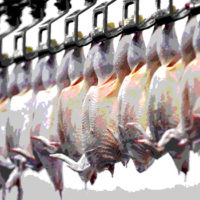For food quality managers, protecting consumers from ingesting metal contaminants is becoming an increasingly high priority. Escapes of unwanted metal in packaged foods can have disastrous effects lasting months or even years, not just in terms of safety but also from a brand and business perspective.
Metal detection has been a standard part of the Hazard Analysis and Critical Control Points method and various codes of practice and regulations worldwide for decades. In recent years, regulatory bodies and retailers have been shoring up food safety protections for consumers. Through laws such as the U.S. Food and Drug Administration's (FDA's) Food Safety Modernization Act, regulators are also taking a more proactive, preventive approach to protecting the food supply. Meanwhile, food producers and distributors are demanding new technology with increased sensitivity to protect consumers, retailers, and their own businesses. Metal detection is an important part of this.
Escapes can result in mandated or voluntary recalls. These recalls are extremely costly and damaging to reputations, often generating publicity on social media and in major U.S. news outlets. In 2017, 12 recalls were issued in the U.S. for foods containing metal foreign material contamination. According to Stericycle’s Recall Index Q1 2018, foreign material was the leading cause of recalled FDA units (53.5%) for the first quarter of this year, and nearly four-fifths (78%) of those were recalled because of metal contaminants.
However, there is also good news. Advances in metal detection technology are enabling dramatically more accurate and reliable detection of hard-to-detect metal contaminants in foods.
Key Metal Detection Challenges
While some escapes of metal foreign objects in food are the result of operational issues, most are caused by the limitations of metal detection technology.
Metal detectors rely on electromagnetic fields to find different types of metal based on their magnetism and conductivity. Accurate detection requires a strong signal-to-noise ratio. Small metal foreign objects have weak signals that can easily be drowned out by “noise” from various hard-to-pinpoint electrical and mechanical sources. The detector can also be confused by vibrations from production equipment, the turning on and off of large motors, electrical power surges or drops, and extreme temperature changes. Eliminating those environmental factors is difficult, expensive and even impractical, in some cases.
Many types, shapes, and sizes of metal—from an employee’s earring to metal fragments from equipment—can find their way into foods as they go through production/processing and packaging facilities. Stainless steel alloys that combine multiple metallic elements are very common and are also the most difficult to detect due to their low iron content. The orientation and position of the metal also can change the way it is “seen” by a metal detector.
Many foods have a naturally high moisture content (or are wet from washing/rinsing) or contain salt or other minerals that appear conductive or magnetic when subjected to magnetic fields. Examples of foods that have a high product effect include spinach, which is naturally high in iron and moisture; breakfast cereals fortified with minerals such as iron; and cocoa powder, which can contain copper, magnesium, iron, and zinc. Product effect makes it difficult for the metal detector to distinguish between the food products themselves and any metal contaminants they may contain. Stainless steel can be especially hard to detect because its signal is very similar to wet/high moisture, salty, or mineral-rich foods, including certain meats, poultry, seafood, cheeses, fresh fruits and vegetables, and ready-to-eat meals.
Technicians have been forced to select an optimal frequency—or pair of frequencies—for detecting metal foreign objects in one or more products based on trial and error. However, no single frequency or pair of frequencies can be optimal for detecting every type, shape, size, orientation, and position of metal contaminant. Single-, dual-, and variable-frequency detectors all require significant compromises in detection sensitivity. Despite technological improvements, the frequency of escapes in the food and beverage industry remains unacceptable.
The Ideal Approach
While no technology is perfect, some metal detection systems are better than others at preventing escapes. Just as the best building security systems use locks, cameras, sensors, fences, and guards for maximum effectiveness, the best systems for protecting the food supply from metal contaminants use multiple methods to detect anomalies. Ideally, a metal detector could sweep a wide range of frequencies at the same time to maximize the probability of finding a random metal contaminant.
Until now, however, factors such as hardware cost, technical complexity, and user set-up challenges have made this approach impractical.
Multiscan technology is a major advance in metal detection technology for the food and beverage industry. Metal detectors with this technology can operate at up to five user-adjustable frequencies between 50 kHz and 1 MHz at a time, scanning through them so quickly (1,000 times per second) that the selected frequencies are in use virtually simultaneously to optimize detection and ignore the product effect. By enabling scanning at as many as five frequencies at once, this innovative technology can find previously undetectable metal types and sizes, because metals that are not detectable at one frequency can be detected at one of the others.
The most exciting aspect of multiscan technology is its unmatched sensitivity, which enables quality managers to identify metallic contaminants as much as 50 percent smaller in volume than they could with previous technologies. The Thermo Scientific Sentinel multiscan metal detector is the first instrument to incorporate this technology, and it also addresses the problems of complexity, thereby making set-up, use, and maintenance as easy as possible.
Unprecedentedly Low Escape Probability
Using only one or two fixed—or even variable—frequencies to detect metal foreign objects in foods is extremely challenging. This is true even in foods that don’t have a high product effect, because metal contaminants are rarely, if ever, perfect spheres of ferrous or nonferrous (e.g., bronze, brass) metal or stainless steel. Multiscan technology can scan at up to five independent, optimized frequencies, making it just like having five independent metal detectors in a line. This means the probability of an escape is reduced exponentially. While no technology can guarantee 100 percent accuracy, multiscan decreases the chance of an escape to almost zero.
When escapes can nearly be eliminated, and the root cause of metal foreign objects is determined quickly and easily, it becomes possible to achieve dramatic improvements in food safety. The high costs of rework, scrap, and recalls can be reduced or eliminated, along with the threat of recall-related damage to brand reputations.
Bob Ries is a lead product manager, X-ray inspection and metal detection at Thermo Fisher Scientific.




